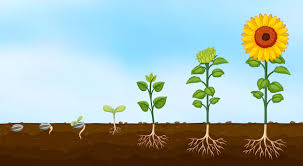Plant growth encompasses the initiation, expansion, and specialization of cells. The haploid spore or diploid zygote of land plants undergoes continuous mitotic cell divisions early in development.
As the plant matures into gametophytes or sporophytes, cell divisions become limited to specific regions known as meristems. In vascular plants, apical meristems are located at the tips of roots and shoots, driving growth in height or length.
Apical meristems can either consist of a single enlarged initial cell, found in groups such as Selaginellaceae and monilophytes, or a group of actively dividing cells, as seen in Lycopodiaceae, Isoetaceae, and seed plants.
In woody plants, both apical meristems and lateral meristems are present. Lateral meristems form cylindrical sheaths of cells responsible for increasing the plant’s width or girth.
Read Also: Significance and Uses of Frozen Flowers
Primary and Secondary Growth in Plants

Growth in plants is evident as the stems and roots elongate. Some plants, especially woody species, also increase in thickness over time. The elongation of shoots and roots is referred to as primary growth, which occurs due to cell division in the shoot apical meristem.
In both apical and lateral meristems, a meristematic cell undergoes mitosis, giving rise to two cells. These cells undergo expansion, but only those near the meristem continue dividing, while others cease mitosis and begin differentiation.
Cell Differentiation and Specialization in Plants
Cell differentiation involves the transformation of a meristematic cell into a specialized cell with a specific structure and function. Differentiation involves two main processes:
1. Cell Expansion: Cells grow in size, often elongating in the axial direction.
2. Maturation or Specialization: Cells acquire structural and functional characteristics, becoming specialized for various roles within the plant. This process leads to the formation of different cell types and tissues.
Read Also: All You Need To Know About Small White Flowers
Plant Tissue Classification

In vascular plants, tissues are classified into three main categories based on their structure and function:
1. Ground Tissue: This tissue forms the bulk of the plant and is responsible for various essential functions such as photosynthesis, storage, and support.
It is further divided into three types of cells: parenchyma (involved in photosynthesis and storage), collenchyma (provides support and flexibility), and sclerenchyma (provides strength due to its thick walls).
2. Vascular Tissue: This is the transport system of the plant, consisting of two main components: xylem and phloem. The xylem transports water and minerals from the roots to the rest of the plant, while the phloem distributes sugars and other organic nutrients produced during photosynthesis.
3. Dermal Tissue: This forms the outermost layer of the plant and acts as a protective covering. It includes the epidermis, which protects against water loss, disease, and damage, and may also have specialized structures like stomata for gas exchange or trichomes for defense against herbivores.
Tissues can be simple, consisting of a single cell type, or complex, composed of multiple cell types. Complex tissues play a critical role in the efficient transport of nutrients, water, and other substances vital for plant growth.
In conclusion, understanding plant growth and the functions of meristems, cell differentiation, and tissue specialization is essential for optimizing agricultural practices and improving crop yield.
Do you have any questions, suggestions, or contributions? If so, please feel free to use the comment box below to share your thoughts. We also encourage you to kindly share this information with others who might benefit from it. Since we can’t reach everyone at once, we truly appreciate your help in spreading the word. Thank you so much for your support and for sharing!
Frequently Asked Questions
We will update this section soon.

